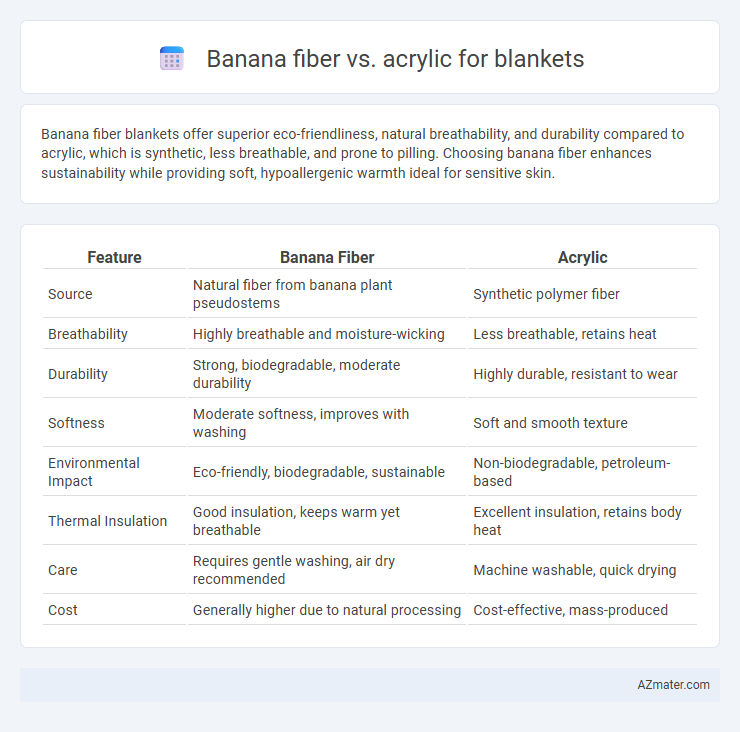Banana fiber blankets offer superior eco-friendliness, natural breathability, and durability compared to acrylic, which is synthetic, less breathable, and prone to pilling. Choosing banana fiber enhances sustainability while providing soft, hypoallergenic warmth ideal for sensitive skin.
Table of Comparison
| Feature | Banana Fiber | Acrylic |
|---|---|---|
| Source | Natural fiber from banana plant pseudostems | Synthetic polymer fiber |
| Breathability | Highly breathable and moisture-wicking | Less breathable, retains heat |
| Durability | Strong, biodegradable, moderate durability | Highly durable, resistant to wear |
| Softness | Moderate softness, improves with washing | Soft and smooth texture |
| Environmental Impact | Eco-friendly, biodegradable, sustainable | Non-biodegradable, petroleum-based |
| Thermal Insulation | Good insulation, keeps warm yet breathable | Excellent insulation, retains body heat |
| Care | Requires gentle washing, air dry recommended | Machine washable, quick drying |
| Cost | Generally higher due to natural processing | Cost-effective, mass-produced |
Introduction to Banana Fiber and Acrylic
Banana fiber, derived from the pseudostem of banana plants, offers a natural, biodegradable, and sustainable alternative for textile applications such as blankets. Acrylic, a synthetic fiber made from polymerized acrylonitrile, is known for its softness, warmth, and affordability in blanket production. Comparing banana fiber and acrylic involves evaluating eco-friendliness, durability, moisture-wicking properties, and comfort levels for optimal blanket performance.
Sourcing and Sustainability
Banana fiber, derived from the agricultural waste of banana plants, is a highly sustainable option for blankets due to its natural biodegradability and renewable sourcing, reducing reliance on synthetic materials. Acrylic, a synthetic fiber made from petrochemicals, involves energy-intensive production processes and contributes to microplastic pollution, posing environmental challenges. Choosing banana fiber blankets supports eco-friendly practices by utilizing renewable resources and minimizing environmental impact compared to conventional acrylic alternatives.
Production Process
Banana fiber blankets are crafted using natural fibers extracted from banana plant stems through a labor-intensive process involving retting, stripping, and drying, which emphasizes sustainability and eco-friendliness. Acrylic blankets are produced synthetically through polymerization and spinning of acrylonitrile monomers, allowing mass production with consistent texture and durability. The natural production of banana fiber results in breathable, biodegradable blankets, whereas acrylic manufacturing relies on petrochemical processes that offer greater resistance to wear and moisture but at an environmental cost.
Texture and Comfort Comparison
Banana fiber blankets offer a natural, coarse texture that becomes softer with use, providing breathable comfort and excellent moisture-wicking properties ideal for warm climates. Acrylic blankets mimic the softness of wool, delivering a plush, smooth feel with greater warmth retention and hypoallergenic benefits. While banana fiber is eco-friendly and lightweight, acrylic provides consistent softness and durability, making it suitable for varied comfort preferences.
Warmth and Insulation Properties
Banana fiber offers superior warmth and natural insulation due to its breathable, moisture-wicking structure, which helps regulate body temperature effectively in blankets. Acrylic fibers provide good thermal insulation and softness but tend to retain heat more, sometimes causing overheating during extended use. Choosing banana fiber blankets enhances warmth with better temperature control, while acrylic blankets deliver consistent warmth through synthetic insulation.
Durability and Longevity
Banana fiber blankets offer superior durability due to their strong natural cellulose content, which resists wear and tear better than synthetic fibers. Acrylic blankets, while soft and lightweight, tend to pill and degrade faster with repeated washing and friction. Over time, banana fiber blankets maintain their structural integrity and appearance, making them a longer-lasting choice for sustainable bedding.
Breathability and Moisture Management
Banana fiber offers superior breathability and moisture-wicking properties compared to acrylic, making it ideal for blankets used in warm or humid climates. The natural cellulose structure of banana fiber allows air circulation and efficiently absorbs and releases moisture, enhancing comfort and reducing sweat buildup. Acrylic, being synthetic, tends to trap heat and moisture, resulting in less effective moisture management and reduced breathability.
Environmental Impact
Banana fiber blankets have a significantly lower environmental impact compared to acrylic, as banana fiber is a biodegradable, renewable resource derived from agricultural waste, reducing landfill waste and chemical usage. In contrast, acrylic is a synthetic fiber made from petrochemicals, contributing to non-renewable resource depletion and microplastic pollution in oceans. Choosing banana fiber supports sustainable agriculture and minimizes carbon footprint, promoting eco-friendly textile production.
Cost and Market Availability
Banana fiber blankets typically cost more due to the eco-friendly, labor-intensive extraction process and limited large-scale production, resulting in lower market availability compared to acrylic blankets. Acrylic blankets offer a more affordable price point, benefiting from mass production and widespread distribution across retail platforms. Consumers prioritizing budget and accessibility often choose acrylic, while those seeking sustainable options may invest in banana fiber despite its higher cost and niche market presence.
Final Verdict: Which is Better for Blankets?
Banana fiber blankets offer superior sustainability, breathability, and natural biodegradability compared to acrylic, which is a synthetic material known for durability and affordability but lacks eco-friendliness. The natural moisture-wicking and hypoallergenic properties of banana fiber make it ideal for individuals with sensitive skin or allergies, while acrylic provides easier maintenance and resistance to wear. For environmentally conscious consumers prioritizing comfort and natural fibers, banana fiber is the better choice; for those seeking budget-friendly and durable options, acrylic remains a viable alternative.

Infographic: Banana fiber vs Acrylic for Blanket
 azmater.com
azmater.com